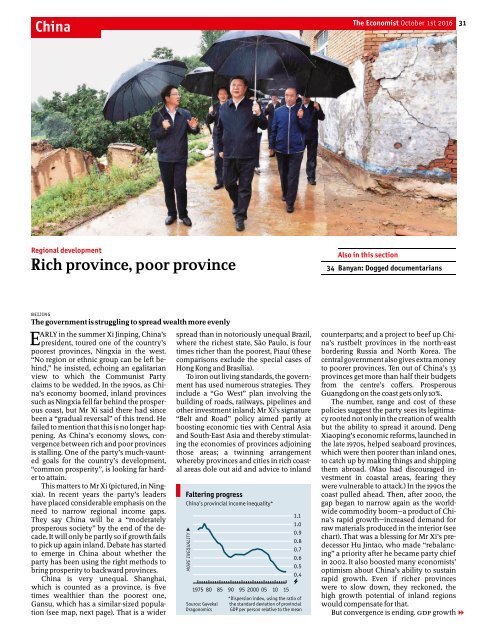Create successful ePaper yourself
Turn your PDF publications into a flip-book with our unique Google optimized e-Paper software.
China<br />
<strong>The</strong> <strong>Economist</strong> October 1st 2016 31<br />
Regional development<br />
Rich province, poor province<br />
Also in this section<br />
34 Banyan: Dogged documentarians<br />
BEIJING<br />
<strong>The</strong> government is struggling to spread wealth more evenly<br />
EARLY in the summer Xi Jinping, China’s<br />
president, toured one of the country’s<br />
poorest provinces, Ningxia in the west.<br />
“No region or ethnic group can be left behind,”<br />
he insisted, echoing an egalitarian<br />
view to which the Communist Party<br />
claims to be wedded. In the 1990s, as China’s<br />
economy boomed, inland provinces<br />
such as Ningxia fell far behind the prosperous<br />
coast, but Mr Xi said there had since<br />
been a “gradual reversal” of this trend. He<br />
failed to mention that this is no longer happening.<br />
As China’s economy slows, convergence<br />
between rich and poor provinces<br />
is stalling. One of the party’s much-vaunted<br />
goals for the country’s development,<br />
“common prosperity”, is looking far harder<br />
to attain.<br />
This matters to Mr Xi (pictured, in Ningxia).<br />
In recent years the party’s leaders<br />
have placed considerable emphasis on the<br />
need to narrow regional income gaps.<br />
<strong>The</strong>y say China will be a “moderately<br />
prosperous society” by the end of the decade.<br />
It will only be partly so ifgrowth fails<br />
to pick up again inland. Debate has started<br />
to emerge in China about whether the<br />
party has been using the right methods to<br />
bring prosperity to backward provinces.<br />
China is very unequal. Shanghai,<br />
which is counted as a province, is five<br />
times wealthier than the poorest one,<br />
Gansu, which has a similar-sized population<br />
(see map, next page). That is a wider<br />
spread than in notoriously unequal Brazil,<br />
where the richest state, São Paulo, is four<br />
times richer than the poorest, Piauí (these<br />
comparisons exclude the special cases of<br />
Hong Kong and Brasília).<br />
To iron out living standards, the government<br />
has used numerous strategies. <strong>The</strong>y<br />
include a “Go West” plan involving the<br />
building of roads, railways, pipelines and<br />
other investment inland; Mr Xi’s signature<br />
“Belt and Road” policy aimed partly at<br />
boosting economic ties with Central Asia<br />
and South-East Asia and thereby stimulating<br />
the economies of provinces adjoining<br />
those areas; a twinning arrangement<br />
whereby provinces and cities in rich coastal<br />
areas dole out aid and advice to inland<br />
Faltering progress<br />
China’s provincial income inequality*<br />
MORE INEQUALITY<br />
1975 80 85 90 95 2000 05 10 15<br />
Source: Gavekal<br />
Dragonomics<br />
1.1<br />
1.0<br />
0.9<br />
0.8<br />
0.7<br />
0.6<br />
0.5<br />
0.4<br />
*Dispersion index, using the ratio of<br />
the standard deviation of provincial<br />
GDP per person relative to the mean<br />
counterparts; and a project to beef up China’s<br />
rustbelt provinces in the north-east<br />
bordering Russia and North Korea. <strong>The</strong><br />
central governmentalso givesextra money<br />
to poorer provinces. Ten out of China’s 33<br />
provinces get more than half their budgets<br />
from the centre’s coffers. Prosperous<br />
Guangdong on the coast gets only10%.<br />
<strong>The</strong> number, range and cost of these<br />
policies suggest the party sees its legitimacyrooted<br />
notonlyin the creation of wealth<br />
but the ability to spread it around. Deng<br />
Xiaoping’s economic reforms, launched in<br />
the late 1970s, helped seaboard provinces,<br />
which were then poorer than inland ones,<br />
to catch up by making things and shipping<br />
them abroad. (Mao had discouraged investment<br />
in coastal areas, fearing they<br />
were vulnerable to attack.) In the 1990s the<br />
coast pulled ahead. <strong>The</strong>n, after 2000, the<br />
gap began to narrow again as the worldwide<br />
commodity boom—a product of China’s<br />
rapid growth—increased demand for<br />
raw materials produced in the interior (see<br />
chart). That was a blessing for Mr Xi’s predecessor<br />
Hu Jintao, who made “rebalancing”<br />
a priority after he became party chief<br />
in 2002. It also boosted many economists’<br />
optimism about China’s ability to sustain<br />
rapid growth. Even if richer provinces<br />
were to slow down, they reckoned, the<br />
high growth potential of inland regions<br />
would compensate for that.<br />
But convergence is ending. GDP growth 1


